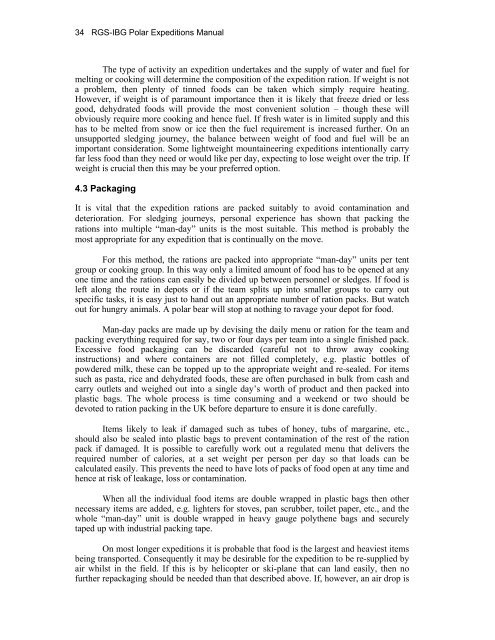Edited by Rachel Duncan 4th Edition ISBN 0-907649-91-2 London ...
Edited by Rachel Duncan 4th Edition ISBN 0-907649-91-2 London ...
Edited by Rachel Duncan 4th Edition ISBN 0-907649-91-2 London ...
Create successful ePaper yourself
Turn your PDF publications into a flip-book with our unique Google optimized e-Paper software.
34 RGS-IBG Polar Expeditions Manual<br />
The type of activity an expedition undertakes and the supply of water and fuel for<br />
melting or cooking will determine the composition of the expedition ration. If weight is not<br />
a problem, then plenty of tinned foods can be taken which simply require heating.<br />
However, if weight is of paramount importance then it is likely that freeze dried or less<br />
good, dehydrated foods will provide the most convenient solution – though these will<br />
obviously require more cooking and hence fuel. If fresh water is in limited supply and this<br />
has to be melted from snow or ice then the fuel requirement is increased further. On an<br />
unsupported sledging journey, the balance between weight of food and fuel will be an<br />
important consideration. Some lightweight mountaineering expeditions intentionally carry<br />
far less food than they need or would like per day, expecting to lose weight over the trip. If<br />
weight is crucial then this may be your preferred option.<br />
4.3 Packaging<br />
It is vital that the expedition rations are packed suitably to avoid contamination and<br />
deterioration. For sledging journeys, personal experience has shown that packing the<br />
rations into multiple “man-day” units is the most suitable. This method is probably the<br />
most appropriate for any expedition that is continually on the move.<br />
For this method, the rations are packed into appropriate “man-day” units per tent<br />
group or cooking group. In this way only a limited amount of food has to be opened at any<br />
one time and the rations can easily be divided up between personnel or sledges. If food is<br />
left along the route in depots or if the team splits up into smaller groups to carry out<br />
specific tasks, it is easy just to hand out an appropriate number of ration packs. But watch<br />
out for hungry animals. A polar bear will stop at nothing to ravage your depot for food.<br />
Man-day packs are made up <strong>by</strong> devising the daily menu or ration for the team and<br />
packing everything required for say, two or four days per team into a single finished pack.<br />
Excessive food packaging can be discarded (careful not to throw away cooking<br />
instructions) and where containers are not filled completely, e.g. plastic bottles of<br />
powdered milk, these can be topped up to the appropriate weight and re-sealed. For items<br />
such as pasta, rice and dehydrated foods, these are often purchased in bulk from cash and<br />
carry outlets and weighed out into a single day’s worth of product and then packed into<br />
plastic bags. The whole process is time consuming and a weekend or two should be<br />
devoted to ration packing in the UK before departure to ensure it is done carefully.<br />
Items likely to leak if damaged such as tubes of honey, tubs of margarine, etc.,<br />
should also be sealed into plastic bags to prevent contamination of the rest of the ration<br />
pack if damaged. It is possible to carefully work out a regulated menu that delivers the<br />
required number of calories, at a set weight per person per day so that loads can be<br />
calculated easily. This prevents the need to have lots of packs of food open at any time and<br />
hence at risk of leakage, loss or contamination.<br />
When all the individual food items are double wrapped in plastic bags then other<br />
necessary items are added, e.g. lighters for stoves, pan scrubber, toilet paper, etc., and the<br />
whole “man-day” unit is double wrapped in heavy gauge polythene bags and securely<br />
taped up with industrial packing tape.<br />
On most longer expeditions it is probable that food is the largest and heaviest items<br />
being transported. Consequently it may be desirable for the expedition to be re-supplied <strong>by</strong><br />
air whilst in the field. If this is <strong>by</strong> helicopter or ski-plane that can land easily, then no<br />
further repackaging should be needed than that described above. If, however, an air drop is

















